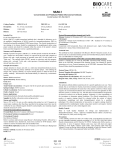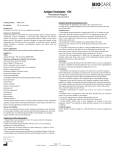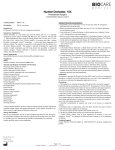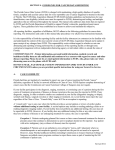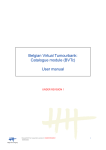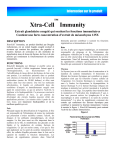Download Data Sheet
Transcript
CD5 (M) Concentrated and Prediluted Monoclonal Antibody Control Number: 901-099-032415 Catalog Number: CM 099 A, C PM 099 AA OAI 099 T60 Description: 0.1, 1.0 ml, concentrated 6.0 ml, prediluted 60 tests, prediluted Dilution: 1:50 -1:100 Ready-to-use Ready-to-use Diluent: Van Gogh Yellow N/A N/A Intended Use: For In Vitro Diagnostic Use CD5 (M) [4C7] is a mouse monoclonal antibody that is intended for laboratory use in the qualitative identification of CD5 protein by immunohistochemistry (IHC) in formalin-fixed paraffin-embedded (FFPE) human tissues. The clinical interpretation of any staining or its absence should be complemented by morphological studies using proper controls and should be evaluated within the context of the patient’s clinical history and other diagnostic tests by a qualified pathologist. Summary and Explanation: CD5 is a T-cell associated marker that is also expressed by two B-cell neoplasms; lymphocytic leukemia and mantle cell lymphoma. CD5 antigen is expressed in 95% of thymocytes and 72% of peripheral blood lymphocytes. In lymph nodes, CD5 is mainly reactive with T-cells. It has been shown to react with thymic carcinomas, but rarely in thymomas. It has also been observed in a subset of intravascular large B-cell lymphomas and marks some anaplastic large cell lymphomas. CD5 has proven very useful in marking mantle cell lymphoma when used in tandem with CD23, cyclin D1, and CD10 (CD10 is negative; CD5, cyclin D1 are positive for mantle cell lymphoma). Principle of Procedure: Antigen detection in tissues and cells is a multi-step immunohistochemical process. The initial step binds the primary antibody to its specific epitope. A secondary antibody may be applied to bind the primary antibody, followed by an enzyme labeled polymer; or an enzyme labeled polymer may be applied directly to bind the primary antibody. The detection of the bound primary antibody is evidenced by an enzyme-mediated colorimetric reaction. Source: Mouse monoclonal Species Reactivity: Human; others not tested Clone: 4C7 Isotype: IgG1/kappa Epitope/Antigen: CD5 Total Protein Concentration: ~10 mg/ml. Call for lot specific Ig concentration. Cellular Localization: Cytoplasmic and cell membrane Positive Control: Mantle cell lymphoma Known Applications: Immunohistochemistry (formalin-fixed paraffin-embedded tissues) Supplied As: Buffer with protein carrier and preservative Storage and Stability: Store at 2ºC to 8ºC. Do not use after expiration date printed on vial. If reagents are stored under conditions other than those specified in the package insert, they must be verified by the user. Diluted reagents should be used promptly; any remaining reagent should be stored at 2ºC to 8ºC. Protocol Recommendations (manual use): Peroxide Block: Block for 5 minutes with Biocare's Peroxidazed 1. Pretreatment Solution: Borg Pretreatment Protocol: Heat Retrieval Method: Retrieve sections under pressure using Biocare's Decloaking Chamber followed by a wash in distilled water; alternatively, steam tissue sections for 45-60 minutes. Allow solution to cool for 10 minutes then was in distilled water. ISO 9001&13485 CERTIFIED Protocol Recommendations (manual use) Cont'd: Protein Block (Optional): Incubate for 5-10 minutes at RT with Biocare's Background Punisher. Primary Antibody: Incubate for 30 minutes at RT. Probe: Incubate for 10 minutes at RT with a secondary probe. Polymer: Incubate for 10 minutes at RT with a tertiary polymer. Chromogen: Incubate for 5 minutes at RT with Biocare’s DAB – OR – Incubate for 5-7 minutes at RT with Biocare’s Warp Red. Counterstain: Counterstain with hematoxylin. Rinse with deionized water. Apply Tacha's Bluing Solution for 1 minute. Rinse with deionized water. Technical Note: This antibody has been standardized with Biocare's MACH 4 detection system. It can also be used on an automated staining system and with other Biocare polymer detection kits. Use TBS buffer for washing steps. Protocol Recommendations (ONCORE Automated Slide Staining System): OAI099 is intended for use with the ONCORE Automated Slide Staining System. Refer to the ONCORE Automated Slide Staining System User Manual for specific instructions on its use. Protocol parameters in the ONCORE Automated Slide Stainer Protocol Editor should be programmed as follows: Protocol Name: CD5 Protocol Template (Description): Ms HRP Template 1 Dewaxing (DS Option): DS2 Antigen Retrieval (AR Option): AR2, low pH; 101°C Reagent Name, Time, Temp.: CD5, 30 min., 25°C Limitations: The optimum antibody dilution and protocols for a specific application can vary. These include, but are not limited to: fixation, heat-retrieval method, incubation times, tissue section thickness and detection kit used. Due to the superior sensitivity of these unique reagents, the recommended incubation times and titers listed are not applicable to other detection systems, as results may vary. The data sheet recommendations and protocols are based on exclusive use of Biocare products. Ultimately, it is the responsibility of the investigator to determine optimal conditions. The clinical interpretation of any positive or negative staining should be evaluated within the context of clinical presentation, morphology and other histopathological criteria by a qualified pathologist. The clinical interpretation of any positive or negative staining should be complemented by morphological studies using proper positive and negative internal and external controls as well as other diagnostic tests. Quality Control: Refer to CLSI Quality Standards for Design and Implementation of Immunohistochemistry Assays; Approved Guideline-Second edition (I/LA28-A2). CLSI Wayne, PA, USA (www.clsi.org). 2011. Precautions: 1. This antibody contains less than 0.1% sodium azide. Concentrations less than 0.1% are not reportable hazardous materials according to U.S. 29 CFR 1910.1200, OSHA Hazard communication and EC Directive 91/155/EC. Sodium azide (NaN3) used as a preservative is toxic if ingested. Sodium azide may react with lead and copper Page 1 of 2 CD5 (M) Concentrated and Prediluted Monoclonal Antibody Control Number: 901-099-032415 Precautions Cont'd: plumbing to form highly explosive metal azides. Upon disposal, flush with large volumes of water to prevent azide build-up in plumbing. (Center for Disease Control, 1976, National Institute of Occupational Safety and Health, 1976) (7) 2. Specimens, before and after fixation, and all materials exposed to them should be handled as if capable of transmitting infection and disposed of with proper precautions. Never pipette reagents by mouth and avoid contacting the skin and mucous membranes with reagents and specimens. If reagents or specimens come in contact with sensitive areas, wash with copious amounts of water. (8) 3. Microbial contamination of reagents may result in an increase in nonspecific staining. 4. Incubation times or temperatures other than those specified may give erroneous results. The user must validate any such change. 5. Do not use reagent after the expiration date printed on the vial. 6. The SDS is available upon request and is located at http://biocare.net/. ISO 9001&13485 CERTIFIED Troubleshooting: Follow the antibody specific protocol recommendations according to data sheet provided. If atypical results occur, contact Biocare's Technical Support at 1-800-542-2002. References: 1. Tateyama H, et al. Immunoreactivity of a new CD5 antibody with normal epithelium and malignant tumors including thymic carcinoma. Am J Clin Pathol. 1999 Feb;111(2):235-40. 2. Kornstein MJ, Rosai J. CD5 labeling of thymic carcinomas and other nonlymphoid neoplasms. Am J Clin Pathol. 1998 Jun;109(6):722-6. 3. de Leon ED, et al. Usefulness of an immunohistochemical panel in paraffinembedded tissues for the differentiation of B-cell non-Hodgkin's lymphomas of small lymphocytes. Mod Pathol. 1998 Nov;11(11):1046-51. 4. Khalidi HS, et al. Intravascular large B-cell lymphoma: the CD5 antigen is expressed by a subset of cases. Mod Pathol. 1998 Oct;11(10):983-8. 5. Jeon HJ, et al. Establishment and characterization of a mantle cell lymphoma cell line. Br J Haematol. 1998 Sep;102(5):1323-6. 6. Kaufmann O, et al. Immunohistochemical detection of CD5 with monoclonal antibody 4C7 on paraffin sections. Am J Clin Pathol. 1997 Dec;108(6):669-73. 7. Center for Disease Control Manual. Guide: Safety Management, NO. CDC-22, Atlanta, GA. April 30, 1976 "Decontamination of Laboratory Sink Drains to Remove Azide Salts." 8. Clinical and Laboratory Standards Institute (CLSI). Protection of Laboratory Workers from Occupationally Acquired Infections; Approved Guideline-Fourth Edition CLSI document M29-A4 Wayne, PA 2014. Page 2 of 2


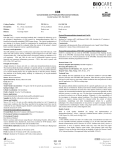
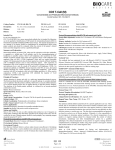
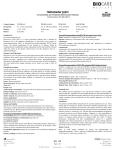

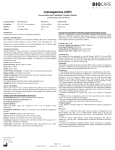
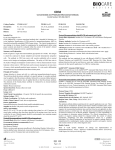
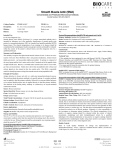
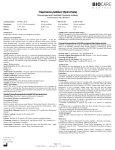
![Progesterone Receptor (PR) [16]](http://vs1.manualzilla.com/store/data/005703733_1-5d4a6a4c070c4aacc906912b3410a27a-150x150.png)
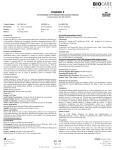
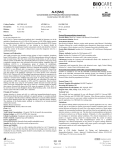
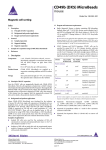
![Estrogen Receptor (ER) [SP1]](http://vs1.manualzilla.com/store/data/005885543_1-e9d75303a2a759dcb2dd4dad516aa5ce-150x150.png)
